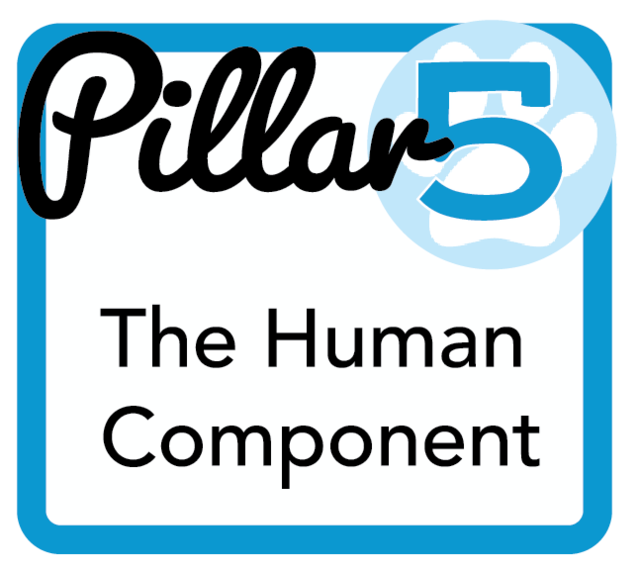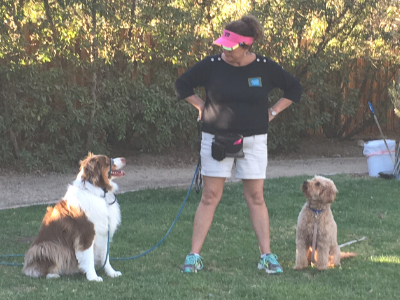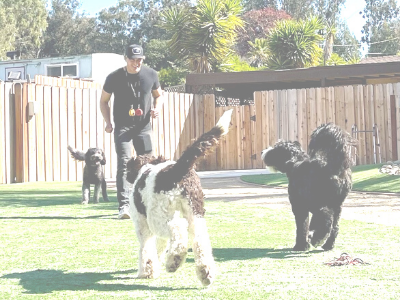
YOU EFFECT YOUR DOG
This Pillar of Dog Training is All About You, the Human Component!
If you need a refresher on our Pillars of Pack Leadership, read PIllar 1, Pillar 2, Pillar 3 and Pillar 4.
The minute you welcome a dog into your life, a conduit of information flow has been established between you and your dog. Your emotions factor into the state of mind of your dog in a significant way. It’s very important that you have the right perspective about how you will interact with your pooch. She should not be the center of your universe. It is a ton of pressure on a dog to be the end all, be all of a human’s life. That kind of intense scrutiny and interaction is way too much for her, and she will be relieved that she doesn’t have to play that role in your life. As you’ve worked your way through this guide, your dog is just now beginning to learn how to JUST BE. She is figuring out that the pleasures in life exist because she can JUST BE.
Dogs are very intuitive and responsive to us, and I know this is not easy to hear, but they often reflect what is going on inside of us. If we are overly concerned about anything (including too concerned for the dog itself), or if the dog is over-the-top in any area (like not letting an owner out of her sight), it is more of a reflection of what is going on in her owner’s head than in hers.
People will say, “Oh look, she’s mad at me.” “Oh, poor baby is scared.” “Oh, she can’t live without me; she goes crazy if she’s out of my sight.” “She knows she did something wrong.” When you say things like that, it usually means that your emotions are being reflected back to you by your pooch.
You see, your dog is a dog. Period.
And although they may not process the world the same way we do, they most certainly will react to all our visible and non-visible emotions. Sure, they have good days, bad days, preferences, favorite things, just like us, but we often use their negative emotions as excuses for allowing inappropriate choices and behavior from them. After all, we have to go to work and perform duties in a safe, sane, and civilized way, even when we don’t really want to. It ought to be the same for your dog.
We humans must acknowledge that the needs of a dog are not the same as the needs of a human. Dogs love to live in the moment. Yes, a dog is a devoted companion, and when there is balance in the relationship, it’s a healthy, wonderful, reciprocated devotion. However, I’ll hear people say, “I just want a lap dog, someone to snuggle with.” My response: get a stuffed animal to squeeze and touch all the time. Dogs don’t do that in their world. Balanced dogs don’t follow another dog around incessantly with eyes glued to the other dog, whining and crying.

Balanced, Happy Dogs
Balanced dogs relax, hang out around each other, lie down, rest; sometimes they’ll romp for a bit, snuggle, then they will JUST BE. If we truly want the best for our dogs, we need to lead by example and help them to become the calm, relaxed, balanced, happy dogs they were meant to be.
Touch, Tone, Timing, and Energy for your Dog
You will hear me say over and over and over: “Touch, tone, timing, and energy.” Mastering these elements will truly make you the best pack leader and senior partner in your relationship with your pooch. Every touch of your leash, every nuanced tone of your voice, every touch of your fingers, every look you give, every move of your body is saying something to your dog. Your job is to ensure that you are saying exactly what you mean to say. Your job is to ensure that you are enforcing or reinforcing exactly the state of mind you desire in your dog.
Touch
We humans touch dogs a lot. Often in ways they really don’t care for. But in our ignorance, bliss, or selfishness, we touch anyway. I can’t tell you how often I’ve heard a client tell me, “I want to pet him to tell him I love him and that he did a good job.” And usually, that dog would have preferred a smile and small scratch under the chin. Most dogs hate being hugged. Many dogs will tolerate it with grace—the smiling face of the family golden retriever with a child’s arms wrapped around its neck comes to mind. But some dogs will feel threatened, fearful, or just flat-out loathe the feeling, and in fact, a child grabbing a dog for a hug is why many dog bites occur. Most dogs dislike being touched on top of the head or on the muzzle, ears, legs, paws, and tail. Additionally, our touch often sabotages the very state of mind we seek in our dogs. Imagine this: You’ve asked your dog for a down. Your dog plops into his down, and you immediately jump down there and enthusiastically pet him. He suddenly jumps up from his down, excitedly wagging his tail. Your touch, what you perceive as a heartfelt “Good boy! Job well done!” for going into his down, actually turned into the very thing that made him disobey and pop up from his down. That doesn’t seem very fair.
For most dogs, a gentle scratch under the chin is usually appreciated. Slow petting, similar to gentle massage or light scratching, can calm a dog down. Place your hand on an area where the dog enjoys being handled and gently move your hand or fingers in the same direction the fur grows. I think the greatest praise we can ever give our dogs is to take the time to notice what kind of touch they actually enjoy. Let’s set our dogs up for success by being mindful about when we touch our dog and by considering the kind of touch that is beneficial to their state of mind.
Tone
A recent scientific study verified what dog trainers have always known—that what we say to our dogs’ matters, how we say it matters, and when we say it matters.
“A recent study conducted at [Sussex University] found that similarly to humans, the verbal and non-verbal (vocal) elements of speech are processed in different areas of the brain. The researchers were looking at the dog’s response to hemispheric biases—left vs. right brain when processing their response to human speech….Subtle variations in your speech pattern or tone of voice, could illicit an opposite response, or reduced response to the task requested….Perhaps your non-verbal intonation pattern had a subtle change in: 1) Volume (loud-soft) 2) Rate (fast-slow) 3) Pitch (high-low) Upward-high; Downward-low Circumflex (high to low; low to high) Even a subtle difference may have communicated a confusing or different request, and therefore, a different response” (Thompson).
Now that science has confirmed what we dog people have observed for years—that the tone of our voice influences are dog’s understanding and response—let me give you an example of how tone used incorrectly can sabotage your dog’s good choices.
You are ready to go out for a walk and start to say in a high-pitched, excited voice, “You ready to go for a walk? Mama is ready! Let’s get your leash. Come on, let’s go!”—and with each increased pitch of your happy voice, your dog gets more and more excited and starts to spin around and jump. Then you wonder why your dog is pulling like a nut on your leash as you head out for your walk.
It’s important that we admit when we weren’t clear or didn’t do something correctly and just fix the issue without wasting time being upset about it. We have to own our part of the equation in our dog’s behavior. We need to say what we mean and say it in a way that sets our dogs up for success. A calm, even, authoritative tone makes your requests clear and understandable to your dog and avoids sending mixed signals.
Timing
Timing is always very critical in training any animal. Whether it be timing of a correction, timing of a treat, or timing of a release of indirect or direct pressure. Release is how the dog knows that he made the right choice and did the right thing. Through the years there have been several studies trying to determine the exact amount of time between the desired action and the timing of the reinforcement to get the desired result of understanding with your dog. The general consensus is—be quick with your praise and treats!
One of the ways we communicate with our dogs is how we respond to them. The timing of those responses can be critical to making sure we are sending the message we intend. Since our dogs don’t understand language like we do, we don’t have the option of simply explaining what we want from them. It becomes more like a game of charades, where we have to catch them doing something right (or something wrong) and help them understand that the behavior they are doing is something we want (or don’t want). It’s a tricky thing and made even more complicated if our timing isn’t good. Being consistent and timely in our rewards/corrections will help reinforce the behavior we are looking for.
Energy
Your energy is also essential. I’ll even go so far as to call it authentic energy! You simply cannot lie to a dog. You can tell me that you are calm and relaxed until the cows come home, but if that dog knows you’re nervous, we will see it in your dog. You can tell me that you want the dog to stay on place, but when it tests you thirty times by trying to get off, you’ve got an authenticity issue.
Remember when you were a kid and your mom called you to “get in the house!”—and you knew she meant it the last time. How did you know she meant it? She called you three times before that, but on that final time, you knew you were in for trouble if you didn’t high-tail it home. It’s this simple: You need to mean what you say, say what you mean—the first time. And remember, you don’t have to be mean to mean it.
Body Language: Putting It All Together for Teaching your Dog
The first thing to do on this journey of self discovery and development of effective touch, tone, timing, and energy is to watch your body language—and that of dog trainers you love— when working your dog.
Have a friend or family member video you working your dog. Watch videos, tons of videos. Watch a dog trainer’s every body move with a discerning eye. I post videos daily on my Facebook page, Aly’s Puppy Boot Camp, so that my client’s can watch our team working with dogs every day. It is up to you to learn about the importance of body language.
No one can learn this for you. You simply have to get in there and start doing it to the best of your ability. To be effective with your dog, you have to wrap your brain around the fact that everything you do impacts your dog—your touch, tone, timing, and energy. Trust me when I tell you…this takes time. But it’s so worth it! You are learning a foreign language called dog, and it takes an understanding of the art of movement and how it’s applied.
Here are a few things to watch for when studying yourself and different trainers on video—happy homework!
- Watch the body language of the dogs as they are worked. Are they relaxed or tight?
- See the hand position and amount of pressure being applied on the leash. Is the handler’s hand position level with the dog’s nose? Higher, above the head? Off to the side?
- Notice the angle of the human’s body in relation to the dogs. Is it facing directly toward the dog or sideways? On the side or in front of the dog?
- What is the distance from the dog—close or distant?
- When does the handler look at the dog? When does the handler look away?
- When does the handler step forward (apply pressure)? When does the handler step back (release pressure)?
- Where do the handler’s hands move—up, down, or to the side? How quickly—fast or slow? Smooth? Steady or jerking pressure?
- What was happening with the dog when the handler moved his or her hands?
- When did the handler touch the dog? What happens to the dog when touched? Does the dog lean away/look away from the handler when touched? Or does the dog move toward the handler when touched?
- When is a word spoken to the dog? What is being said? (Hint: Look for “name and explain” or “marking” techniques—every time I say hi or good or yes, that is a marker for something specific we’ve seen in a dog’s decision.)
- When is a treat given? What happens to the dog when treated? Is the dog growing calmer, more focused, or does the dog get more excited?
- Good dog communicators breathe. Notice when they exhale.
- When does the handler move into a strong standing position with hands on hips?
- Where are the handler’s feet? (Together or slightly apart and angled?)
- When does the handler make directional changes? When does the handler move forward, backward, sideways? When does the handler turn left, right, or about-face?
- When is the handler standing still? How long?
The overarching truth is that you are saying something to your dog at all times, you just have to be certain that your touch, tone, timing, and energy are all saying what you intend to say.

